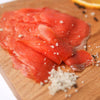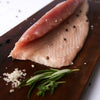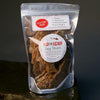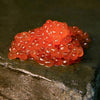It’s officially September, which means that by now, our fishermen have returned home from the salty seas of Bristol Bay, Alaska, and our freezers are stocked once again with the freshest wild salmon money can buy.
With this season’s sockeye return clocking in over more than 65 million fish - a number that not only nearly doubles a normal sockeye return in Bristol Bay, but is the largest run ON RECORD since the fishery first started counting back in 1952 - it’s only natural that fishermen, conservationists and Bristol Bay fishery biologists alike are full of amazement and proud to be part of this sustainable, natural resource.
The final count for this year’s total run in the bay landed at 65.73 million according to local radio station KDLG’s last fishery report of the season, but the numbers don’t stop there. Even after head biologists count their last spawning salmon for the season in their respective fishing districts, there are still tons of salmon trickling through each river mouth, finally completing their 2-6 year life journey (7 when including the year spent as an egg in the riverbed) during the few weeks after peak commercial fishing season has closed.

The 2021 Bay-wide final escapement numbers (the number of fish that make it upriver past commercial fishing areas to their spawning grounds) were totaled at 25.6 million, and the total harvest of sockeye salmon bay-wide was 40 million. These numbers fall within the top five escapements and top three harvests ever recorded - making this year’s number of salmon passing through the Bay historical all around!
While there are five districts altogether that make up the Bristol Bay commercial fishery and housed these incredible numbers, the total run and harvest between each district is not always evenly dispersed.
Nushagak District
Nushagak District fishermen were baffled this season when 27.4 million fish came through to spawn up the Nushagak, Wood, and Igushik rivers. While this does not beat the 2018 sockeye run record for the district (33.75 million), it makes up over 40% of the total run in Bristol Bay this year.
These same fishermen were, of course, reeling about these record-breaking harvest numbers, but many were even more thrilled to hear this year’s Nushagak escapement numbers. For many reasons, these numbers make this season even more of a historical event.
In Bristol Bay, each river system within a district has a certain escapement goal. In the Nushagak District, this year’s escapement goals were 370,000-900,000 for the Nushagak River, 1.8 million for the Wood River, and 150,000-400,000 for the Igushik River. Remaining consistent with this year’s extraordinary run and harvest numbers, each river beat the escapement goal set by its lead biologist by well over 3 million fish this year (in the case of the Wood and Igushik rivers, it more than doubled these goals).
Naknek District
The Naknek fishing District was also strong this year, with almost 30% of the total run (19 million) returning to spawn in their home rivers, the Naknek, Kvichak and Alagnek. The forecasted run was just above 17 million fish for this district.
All three rivers also reached or exceeded their 2021 escapement goals, which ranged from 210,000 to 10 million, making for both a successful sockeye spawning season and harvest in the Naknek District.
Ugashik District
The southernmost district in the Bay, Ugashik, also broke records this season by surpassing both total run forecasts (7.5 million counted, 6.5 million forecasted) and escapement goals (2.7 million sockeyes returned to the river to spawn, with an original goal of 1.4 million for the 2021 season).
The moral of this year’s run and escapement story? The 69 years of careful fishery management practices by Alaska Department of Fish and Game and its biologists are in place for a reason. They are not just working well, but exceeding expectations surrounding current salmon conservation efforts, providing lasting proof of their worth in the form of some incredible salmon return figures.
With these figures in mind, a few questions are raised; For one, where are all these fish coming from - and what is the reason behind why there so many reports of smaller fish size this year?
Smaller Fish Meet Warming Waters

In a recent article from Anchorage Daily News, Bristol Bay biologists are quoted saying they believe warming waters are “speeding up the early part of their life cycle across the whole region”, making the Bering Sea suddenly much more crowded.
Alaska Department of Fish and Game (ADFG) biologist Tim Sands of the Nushagak District believes these warmer waters are benefitting the salmon by creating improved feeding conditions in freshwater, ultimately making the salmon eager to get out to the sea earlier to continue the cycle.
ADFG biologist Travis Ellison of the Naknek-Kvichak District agrees. In a live stream interview with Wild for Salmon owner and commercial fisherman Captain Steve Kurian, Ellison shares:
“Some of these higher elevation lakes are producing better than they did in the past because they’re warmer, they’re getting better growing conditions and we’re seeing some life history changes. The sockeye are growing faster and maturing earlier and coming back at a younger age.”
For reference, Sockeye usually spend 2 years in freshwater, then 1 - 4 years at sea before returning to their home rivers to spawn. This year, biologists were counting endless numbers of fish who had spent just one year in freshwater, before heading out to sea and back.
Ellison also believes the location of Bristol Bay is a contributor to the run numbers and temperatures they have been seeing.
“...When you look at sockeye distribution throughout the world, Bristol Bay is pretty far North in the range, so as things warm up it becomes more and more ideal for those fish… There’s a period there where it is actually helping them in this region for the time being… I think a big part of that too is [Bristol Bay sockeye] are going into the Bering Sea, whereas most all other sockeye in the world are going into the Gulf of Alaska. We’re seeing big differences in temperatures [and there is a] big buffer by going into the Bering Sea.”

Wild Weather on the Bay
Aside from smaller overall fish size, these larger harvest numbers must have our salty fishermen over-the-moon excited, right?
Not so much. With heavy runs and harvests, also comes heavy nets.
While a giant set is usually cause for celebration, it is also a signal that little to no sleep (for maximum harvest time), hastily-made PB&J’s scarfed down on deck between sets, and mental, emotional and physical exhaustion are just around the corner. Add a couple large storm events to the mix, and you’re looking at the particularly intense and dangerous season spent on the Bay this year.
The weather on the Bay was by no means cause for celebration, with two large easterly wind events happening within the first couple weeks of harvesting season. Around June 23rd, the Nushagak District was hit with gusts of up to 38 knots (that’s roughly 44mph for those less familiar with maritime terms) and stayed strong for a few days. After a quick lull, calm seas and even calmer captains, the wild winds returned for another 3-5 day period that literally “rocked the boats” across the bay. This pattern continued in the Nushagak all season long.

According to an interview with Climate Specialist Rick Thoman of the University of Alaska Fairbanks by KDLG, these two storm events were unusual to see. Traditionally, we see lower pressure and therefore more contrast between warm and cold air in the wintertime, creating those crazy December storms we are all familiar with. But this summer, these lower pressure days were abundant, frequently increasing contrast in air temperatures and ultimately more abnormal weather patterns for our fishermen on the Bay.
An even more real part of commercial fishing in Bristol Bay is the fact that there are lost or damaged vessels every season. This year was a particularly difficult one for fishermen in the Nushagak, as three separate fishing vessels were lost. While most lives were saved, one captain was lost and many hearts were heavy that evening on the Bay. It is these moments that remind our fishermen the true challenges and importance of what it means to be a Bristol Bay fisherman, and, for many, the true cost of wild salmon.
Salmon in Demand
With more fish harvested, an increased price to fishermen and the domestic demand for wild salmon skyrocketing thanks to more localized marketing efforts like fishermen-direct businesses popping up around the U.S., sockeye salmon has become quite the popular item. More people every day are beginning to recognize the incredible health benefits that wild salmon has to offer, turning this sustainable, super traceable form of natural nourishment into the ultimate gift for friends and family year-round.
While pricing will ebb and flow with these changes in demand, there’s one thing you can be sure of; there truly is no greater experience than the taste of wild, Alaskan salmon that comes directly from the fishermen who witness these record-breaking runs first-hand and put their lives on the line each year just to share a taste of the wild with you.
Author Profile





 Wild Alaska Salmon
Wild Alaska Salmon Alaska Salmon Burgers
Alaska Salmon Burgers Smoked Salmon & Seafood
Smoked Salmon & Seafood Wild Alaska Whitefish
Wild Alaska Whitefish Wild Shellfish & Shrimp
Wild Shellfish & Shrimp Wild Albacore Tuna
Wild Albacore Tuna Canned Seafood
Canned Seafood Meal Box & Samplers
Meal Box & Samplers Pet Products
Pet Products Gifts
Gifts Specialty
Specialty Wholesale Ordering
Wholesale Ordering
1 comment
Love reading about the ‘ups and downs’ of your salmon voyage/fishing this summer! Also love every bite of salmon that i take when I order from you………yum! also, great recipes, like the Wild Salmon Chowder which I just made a few days ago!